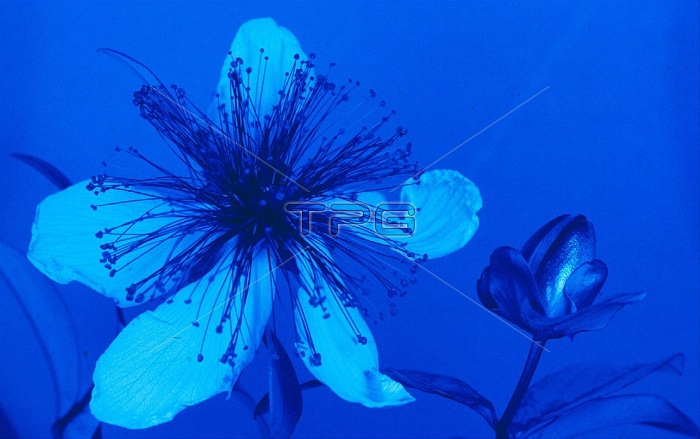
Hypericum calycinum flower and bud (left) as seen by the human eye and (right) as insects with ultraviolet vision are believed to see the flower . . Thomas Eisner/Cornell UniversityCopyright ?Cornell University. High-resolution copIes of these photos (1386 x 870 pixels, about 1MB) are available: visible light and ultraviolet. ITHACA, N.Y. -- When some insects zero in on a flower for nectar, their ultraviolet vision is guided by a bull's-eye "painted" on the plant by chemical compounds. Now, chemical ecologists at Cornell University have discovered a second job for these compounds: warding off herbivores. Even before a flower bud -- such as the creeping St. John's wort -- opens for business, the same chemicals, called DIPs (for dearomatized isoprenylated phloroglucinols), are both coloring the flower in patterns unrecognizable to the human eye and protecting the plant's reproductive apparatus by killing or deterring caterpillars, the scientists report in the upcoming Proceedings of the National Academy of Sciences (Vol. 98, No. 24). This image is copyright ?Cornell University All rights reserved Permission is hereby granted to news media to reproduce this image when reporting Cornell-related news, provided that Cornell University and the photographer or artist are credited. Permission is also extended to private individuals to make copies for personal use not involving physical or electronic distribution. For any other use, for profit or otherwise, please contact Cornell University News Service.
| px | px | dpi | = | cm | x | cm | = | MB |
Details
Creative#:
TOP17541640
Source:
達志影像
Authorization Type:
RM
Release Information:
須由TPG 完整授權
Model Release:
No
Property Release:
No
Right to Privacy:
No
Same folder images:

 Loading
Loading